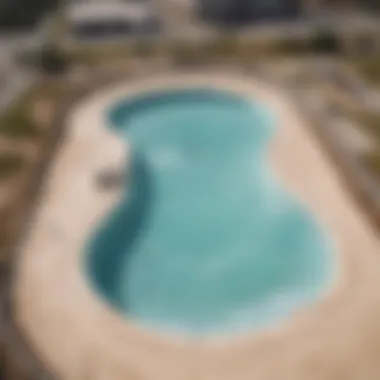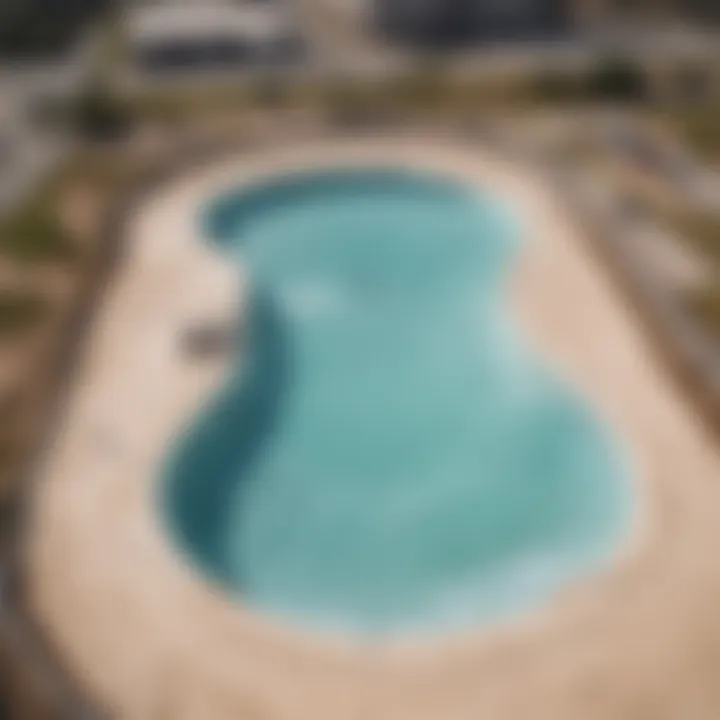Exploring Wave Pool Generators in Aquatic Engineering


Intro
As the popularity of watersports continues to rise, so too does the need for advanced facilities that can cater to this demand. Wave pool generators have emerged as a transformative force in the recreational landscape, offering artificial waves that bring an ocean-like experience to landlocked locations. These technological wonders are not merely structures; they are avenues for athletes, instructors, and adventurers to hone their skills in a controlled environment. From surfing to paddle boarding, the variety of aquatic activities made possible by these wave-generating systems cannot be overstated.
With an increasing number of wave pools popping up around the world, understanding their inner workings becomes crucial. By delving into aspects like design and functionality, this discussion aims to equip enthusiasts with the knowledge to navigate the fascinating world of wave pool technology. Moreover, it spotlights not just the mechanics involved, but also their broader implications for sustainability and efficiency—elements that can’t be ignored given the growing emphasis on eco-friendly recreation.
The journey begins by exploring the essential gear required for both beginners and seasoned wave-sport athletes, transitioning into the depths of how these generators create the waves that thrill users. Whether you’re an aspiring surfer looking to catch your first ride or a professional navigating larger swells, being adequately prepared will make all the difference. Beyond gear, the techniques and safety practices that ensure an enriching and secure experience in these pools deserve thorough examination.
Let’s embark on this exploration to enhance our understanding of wave pool generators and their pivotal role in the watersports community.
Overview of Wave Pool Generators
In the realm of aquatic engineering, wave pool generators stand as a transformative element, facilitating diverse water-based recreation and sports. These systems create artificial waves, allowing enthusiasts to enjoy surfing, swimming, and other water activities regardless of natural conditions. Understanding the core functions and historical context of these generators is paramount. They don't just splash the waves; they open doors to experiences that reconnect people with water in profound ways.
Definition and Functionality
Wave pool generators are intricate systems designed to produce artificial waves in a controlled environment. Fundamentally, they can be likened to the heartbeat of a wave pool. At their core, these machines function by manipulating water through various mechanisms, employing either mechanical, hydraulic, or pneumatic systems to create waves that mimic the ocean's rhythm. The size, frequency, and shape of the waves can be tailored to suit the specific needs of users, whether it’s for training novice surfers or hosting competitions.
Importantly, these generators offer more than just fun; they cater to skill development, as the predictable nature of waves allows athletes to refine their techniques. This is a game changer for both leisure seekers and performance-oriented surfers who benefit from consistent training environments.
History and Development
The origin of wave pool technology is both fascinating and a bit convoluted, originating from early recreational facilities looking to provide year-round aquatic enjoyment. The first wave pools were quite rudimentary, primarily designed in the mid-20th century. These initial models utilized large, inflatable structures and limited paddle mechanisms to generate waves. As technology progressed, so did the complexity and efficiency of these systems.
By the 1980s, advancements in engineering principles began to enhance wave generation, with companies like Surf Loch pioneering designs that could produce waves and surf conditions more akin to coastal reality. Over time, this evolution spiraled, giving rise to a wide array of pool designs capable of serving various purposes—from casual family outings to serious training facilities for budding surfers.
Ultimately, understanding the definition and history of wave pool generators is key for anyone interested in the intersection of technology and recreation in aquatic environments. This knowledge will serve not only to enrich the appreciation of these modern marvels but also to recognize their role within the greater landscape of watersports and engineering.
The Engineering of Wave Pool Generators
The engineering behind wave pool generators is fundamental to their operation and wide-ranging applicability. It’s not just about splashing water around; it’s about crafting an environment that replicates the natural dynamics of the ocean. When you delve into this topic, you recognize how critical it is for both recreational and professional settings. From the materials used in construction to the intricate designs that dictate wave patterns, each decision made by engineers can dramatically affect the user experience.
Interestingly, these designs must balance efficiency and user satisfaction while keeping safety in mind. Engineers are like conductors of a symphony, ensuring each part works in harmony to create an inviting atmosphere for surfers and swimmers alike.
Design Principles
Designing an effective wave pool isn’t merely an exercise in aesthetics; it involves careful consideration of several technical factors. First off, the size of the pool impacts wave generation directly. Larger pools can accommodate bigger or more numerous waves, ideal for competitions. The shape of the pool, often rectangular or circular, also plays a significant role in wave dynamics. You want to mimic the ocean's ebb and flow, which requires an understanding of water physics.
Additionally, material selection cannot be ignored. Engineers often opt for durable materials that withstand continuous water exposure and changing temperatures, ensuring longevity.
Common Technologies Used
This part gets really interesting. There are various technologies utilized in wave pool generators, and they can be generally categorized into three main options; hydraulic, pneumatic, and mechanical systems.
Hydraulic Systems
Hydraulic systems harness the power of water to generate waves. They operate through pumps that create pressurized water, which is then released in specific patterns. This approach is popular mainly because it allows for precise control of wave height and frequency. Not to mention, hydraulic systems can accommodate a wide range of water levels, which is a significant advantage in designing different types of wave pools. A unique feature of these systems is their ability to generate waves that can be finely tuned—this enhances user experience, particularly for surfing. However, maintenance can be complex and costly, as hydraulic systems require regular checks to ensure pump efficiency.
Pneumatic Systems
Pneumatic systems take a different approach by using air pressure to create waves. Air bladders are inflated and deflated to push water towards the pool's surface. This method tends to be quieter than hydraulic systems, and they are easier to maintain because they have fewer moving parts. The key characteristic of pneumatic systems is their adaptability; they can easily create diverse wave profiles suitable for beginner surfers to advanced athletes. However, they may produce less consistent waves compared to hydraulic counterparts, which could be a downside in competitive settings.
Mechanical Systems
Lastly, mechanical systems rely on mechanical devices—such as paddles or walls that push the water directly. Often simpler in design, these systems can generate larger waves suitable for experienced surfers. The distinct feature of mechanical systems is their robust nature and lower operational costs across time, but they may lack some of the versatility found in hydraulic or pneumatic systems. Mechanical systems could easily become less favorable if they can't adjust wave patterns according to varying skill levels.
Overall, understanding these technologies is crucial for anyone involved in the design and operation of wave pools, whether for leisure, training, or competition. Each system has its pros and cons, making it pivotal to select the most appropriate one based on the specific goals of the wave pool.
Types of Wave Pools
Understanding the variety of wave pools is crucial for anyone interested in aquatic engineering, especially when considering their unique applications and benefits. Each type of wave pool caters to different audiences and helps shape the experience of watersports enthusiasts, beginners, and competitive athletes alike. Within the broader context of wave pool technology, these categories serve distinct purposes and often leverage varied engineering techniques to generate waves.
Surf-Specific Wave Pools
Surf-specific wave pools are designed with one main objective: to create optimal surfing conditions. They utilize advanced technologies that replicate the natural ebb and flow of ocean waves, allowing surfers of all skill levels to practice in a controlled environment. The engineering behind these pools focuses on creating waves with specific characteristics, including height, shape, and frequency.
- Typical usage for surf-specific pools includes:
- Skill development: Surf areas like The Wave in Bristol, UK, facilitate the growth of local surfing communities by offering consistent wave patterns ideal for practice.
- Training: Professional athletes benefit from these controlled conditions for honing their techniques without the unpredictability of ocean surf.


However, the construction costs can be quite steep, often making them a luxury investment for niche markets. Despite that, their popularity is surging, supported by increasing interest in surfing as a mainstream sport and the desire for stationary training facilities.
Recreational Wave Pools
Recreational wave pools are family-friendly attractions that create gentle waves suitable for playing and leisure activities. These pools appeal to a wide audience and often feature varying depths and wave strengths to accommodate both children and adults. The engineering behind recreational wave pools focuses on user experience, implementing predictable and non-threatening wave patterns.
- Benefits of recreational wave pools include:
- Accessibility: Families can enjoy a day by the water without needing to venture to the beach, making it a dead giveaway for local water parks.
- Safety: The gentler waves cater to beginners who are looking to build confidence in the water while still providing some excitement.
Locations like Wet 'n Wild in Gold Coast, Australia, illustrate how such aquatic spaces create vibrant social hubs, bringing people together for fun and relaxation.
Competition-Grade Wave Pools
Competition-grade wave pools are engineered to meet the rigorous demands of professional watersports. They provide perfect conditions for competitions, where wave consistency and quality are paramount. These pools are often designed following strict guidelines set by organizations like the World Surf League (WSL) to ensure that athletes can compete under fair conditions.
- Key elements of competition-grade pools include:
- Precision in wave formation: Technologies that allow for precise adjustments to wave height and frequency are essential for competitive environments. Facilities like Surf Ranch in Lemoore, California, have set the benchmark for professional training and events.
- Spectator-friendly design: These pools often include seating and viewing areas, enhancing the spectator experience and drawing larger crowds.
Overall, competition-grade wave pools not only serve as training grounds for pros but also act as venues for major competitive events, highlighting their essential role in the global watersport ecosystem.
What sets these pools apart is their ability to transform traditional surfing and recreation into a more inclusive and accessible experience.
Wave Generation Techniques
When it comes to wave pool generators, the method of wave generation is pivotal. Understanding the techniques behind creating artificial waves shapes not only the structure of these systems but also the experience of the users. Each method—mechanical, pneumatic, and hydraulic—brings its own set of benefits and considerations that affect everything from wave size to consistency. Let's dive into these techniques to uncover how they function and their implications for watersports enthusiasts.
Mechanical Wave Generation
Mechanical wave generation can be likened to the work of a skilled artisan, shaping waves with precision. This technique often uses a series of moving components such as paddles or plows that physically displace water to create waves. The mechanical systems use direct force; think of it as someone striking water with a large stick—once contacting, the splashes that follow are the product of that action.
The advantages of this approach include:
- Control Over Wave Quality: Adjustments can be made to wave height and frequency by simply altering the angle or speed of the moving parts.
- Durability: Mechanical systems often boast sturdiness because they rely on physical components instead of pressurized systems.
However, these systems come with their own challenges. Maintaining gears and bearings can require regular upkeep. Additionally, the noise generated by moving parts might deter those seeking a serene aquatic experience.
Pneumatic Wave Generation
Shifting gears, pneumatic wave generation employs air pressure to manipulate water. This technique uses large air chambers that release bursts of air to create surface waves. Imagine blowing up a balloon and then letting it go; the force of escaping air sends it darting in unpredictable directions. Similarly, compressed air pushes the water outward, forming waves.
Benefits of pneumatic systems include:
- Lower Energy Costs: They often consume less energy than mechanical systems due to their reliance on pressurized air.
- Varying Wave Styles: Adjusting air release can lead to varied wave patterns, allowing for creative configurations that serve different watersport activities.
However, users must recognize that pneumatic systems also come with downsides. Maintaining air pressure levels can be tricky, and the technology may require detailed troubleshooting to ensure optimal performance.
Hydraulic Wave Generation
Finally, we have hydraulic wave generation, which operates on a similar premise to pneumatic systems but leverages water instead. Here, large hydraulic pumps create waves through the movement of water at high velocities. This can be compared to stirring a pot of water rapidly; the disruptions create ripples that expand outward.
The merits of hydraulic wave generation are clear:
- Consistent Wave Production: The volume of water moved allows for a reliable wave-making process, ensuring a steady flow for users.
- Scale Options: These systems can be designed to produce waves of various sizes and shapes, catering to skilled surfers and beginners alike.
On the flip side, hydraulic systems can entail higher initial setup costs and might demand complex designs that need careful engineering for optimal functionality.
"Understanding these wave generation techniques not only informs future developments in aquatic engineering but also shapes the overall experience for users of wave pools."
Impacts of Wave Pool Generators on Watersports
Wave pool generators hold a significant place in the realm of watersports, chiefly due to their ability to create controlled, consistent waves. This article will delve into specific impacts that these structures have on the sport. Not only do they offer numerous benefits to various skill levels, but they also transform how watersports, like surfing and bodyboarding, are perceived and practiced. In this section, we will look closely at how wave pools enhance skill development, promote accessibility for newcomers, and stimulate competitive environments.
Enhancement of Skill Development
Wave pools serve an instrumental purpose in skill development among watersport enthusiasts. Here’s how:
- Consistency of Waves: In natural environments, wave conditions can be unpredictable. A wave pool consistently produces waves of similar height and frequency. This level of predictability allows beginners and experienced surfers alike to hone their skills without the anxiety of sudden shifts or dangerous conditions.
- Safety in Practice: When learning to surf, wipeouts can be daunting. More predictable waves allow for safer practice. The possibility of repeated falls is mitigated in a controlled setting, thus instilling confidence among students. Furthermore, the design of many pools ensures that the wave energy dissipates safely so that surfers can practice without fear.
- Tailored Training: Advanced wave generation technologies enable the creation of varied wave types. This aspect allows coaches to create conditions that mimic particular surfing styles or challenges, enhancing the learning experience.


"In a controlled environment like a wave pool, surfers can push their limits with a safety net beneath them."
Accessibility for Beginners
Another noticeable impact of wave pool generators is their role in making watersports more accessible to beginners. Here are some key contributions:
- Intimidation Factor: Many newcomers find natural oceans intimidating, particularly with the presence of strong currents and marine life. Wave pools remove much of this apprehension. The artificial setting provides an atmosphere conducive to learning and exploration.
- Instruction Availability: Wave pools often come paired with professionals and instructors who are more readily available. This environment facilitates tailored guidance, fostering an effective learning experience.
- Inclusive Facilities: Many modern wave parks are increasingly designed to be inclusive, accommodating individuals of all ages and abilities. Adaptive surfing programs have gained traction, ensuring that everyone has the opportunity to engage with the sport.
Stimulation of Competitive Environments
As interest in watersports grows, the competitive landscape is rapidly evolving. Wave pool generators boost this aspect through:
- Organized Competitions: Many wave pools host regular competitions, offering recognized platforms for surfers to test their skills. This format nurtures a sense of community while allowing competitors to gain critical experience in a structured setting.
- Level Playing Field: Consistent wave production creates a level playing field, minimizing the discrepancies often present in ocean contests. It allows many surfers to compete under the same conditions, thereby enhancing the fairness of competitions.
- Exposure to Talent: Hosting events in artificial wave pools draws attention, not just from spectators but from sponsors and surfing organizations. This exposure can be indispensable for budding athletes trying to make their mark in the surf world.
The Sustainability Factor
As the popularity of wave pools grows, so does the need to address sustainability. This aspect is crucial because it not only affects the environment but also determines the long-term viability of wave pool projects. By focusing on sustainable practices, we can ensure that these recreational spaces remain enjoyable for generations without harming the planet.
Energy Consumption Concerns
Wave pools require significant energy to create and maintain waves. This leads to a stark consideration: how much energy are we willing to spend for leisure? Regular wave generation systems can consume a lot of power, often leading to heightened operational costs and a larger carbon footprint. Many facilities struggle with high utility bills, making it essential to find more efficient ways to harness energy.
Moreover, many wave pool operations rely on unsustainable energy sources. This raises questions about accountability and responsibility in environmental stewardship. If we want these pools to thrive in a world increasingly concerned with climate change, stakeholders must pivot towards greener energy solutions. Integrating renewable energy sources like solar panels or wind turbines could drastically cut down energy consumption and promote sustainability.
Environmental Impact
The environmental implications of wave pools extend beyond just energy use. Construction often requires substantial water resources, land alteration, and potential disruption to local ecosystems. The runoff from pools can introduce chemicals used for maintenance, which can seep into surrounding waterways. All of these factors collectively pose a risk to biodiversity.
Communities located near wave pools may experience changes in their local environment, sometimes even leading to the displacement of native wildlife. It becomes crucial to conduct thorough environmental assessments before breaking ground. Understanding and mitigating the ecological impact is a responsibility shared by engineers, developers, and operators.
"Addressing environmental impacts head-on can ensure that aquatic spaces don’t just exist in harmony with nature but actively contribute to its preservation."
Innovative Solutions for Sustainability
In the quest for sustainability in wave pool engineering, innovation becomes the best ally. Recently, there have been several strides in eco-friendly practices that show promise.
- Closed-loop Water Systems: Implementing systems that recycle water can drastically reduce consumption. This system can minimize the need for constant refilling, effectively conserving this precious resource.
- Biodegradable Chemicals: Operators can opt for environmentally friendly maintenance solutions that do not harm surrounding ecosystems. Many companies are developing biodegradable cleaning agents specifically for aquatic settings.
- Energy Harvesting Technologies: Advances in technology mean that some wave pool generators can also harness energy from the waves they create. This not only offsets energy use but can even lead to energy production.
- Landscaping with Native Plants: Surrounding wave pools with native vegetation can help restore local habitats while also filtering runoff before it reaches natural waterways, creating a symbiotic relationship between leisure and nature.
By putting these innovative solutions into practice, we can significantly reduce the environmental toll of wave pools, transforming them from potential ecological threats into responsible recreational havens.
Economic Aspects of Wave Pools
The discussion around wave pool generators is not only a technical one; it also dives into the economic implications of these structures. In a world increasingly focused on sustainability and recreation, understanding the economic aspects of wave pools unravels their multifaceted role in community development and their potential to generate revenue. It goes beyond mere construction costs to consider their long-term benefits to local economies, job creation, and the tourism sector. This section aims to give you a clear picture of how wave pool generators can be more than just a fun activity but also a viable economic investment.
Costs of Construction and Maintenance
Building a wave pool is a hefty financial endeavor. The initial construction costs can vary considerably based on several factors, such as location, size, and the technology utilized. For instance, installing hydraulic or pneumatic systems often requires in-depth engineering assessments and ongoing maintenance to keep everything running smoothly.
When considering a wave pool for a facility like a resort or water park, the following costs typically arise:
- Site preparation: Clearing and grading the land, which can involve underground utilities.
- Wave generation technology: The heart of the pool - whether mechanical, hydraulic, or pneumatic systems.
- Pool aesthetics: Landscaping, seating areas, and decorative elements attracted to customers.
- Operational costs: These include staffing, maintenance supplies, and energy costs which can be significant due to the machinery required.
Ensuring a proper balance between construction expenses and overall operational efficiency is critical for anyone considering investment in a wave pool facility.
Revenue Generation through Tourism
A well-designed wave pool can act as a magnet for tourists. Placed in the right locale, it provides a thrilling experience that can draw visitors from afar. This influx not only enhances the reputation of the facility but also elevates local businesses, such as hotels, restaurants, and shops.
Key aspects of revenue generation include:
- Entrance fees: Charge per visit or offer season passes to encourage repeat visitors.
- Merchandise sales: From swimwear to souvenirs, there are numerous opportunities for sales.
- Food and beverage sales: Establishing restaurants or snack bars can offer significant return on investment.
- Special events: Hosting surf competitions or water shows can draw crowds that boost ticket sales.
In sum, a wave pool not only heightens the recreational appeal of a resort or park but can significantly enhance the inflow of cash to the local economy.
Job Creation Opportunities
The construction of wave pools contributes directly to job creation in various sectors. From skilled laborers who build the facilities to the management teams that oversee daily operations, wave pools create a ripple effect in the job market.
Here’s a quick look at job categories involved:


- Construction workers: Tradespeople and laborers for building and installing wave pool infrastructure.
- Operators: Staff responsible for maintaining the technology that generates the waves and ensuring safety.
- Customer service staff: Employees in ticket sales, merchandising, and food services.
- Instructors: Trained professionals who can offer surf lessons, enhancing the guest experience.
Creating an engaging environment around wave pools further opens doors for local residents to find employment, fostering community growth.
"Wave pools are transforming the landscape of aquatic recreation while providing significant economic boosts to local communities."
Wave Pool Generators in Different Areas of Application
Wave pool generators have carved a niche not just in the realm of recreational water activities but also across various applications that serve a broader community. Understanding the unique value these systems bring to different environments is crucial for both investors and enthusiasts alike. The versatility of wave generators allows for adaptability in many settings, catering to diverse audiences, from laid-back beachgoers to serious athletes.
Indoor vs. Outdoor Wave Pools
The choice between indoor and outdoor wave pools is often dictated by location, climate, and target audience. Indoor wave pools provide a controlled environment, making them accessible year-round. They are insulated from weather conditions, which can ensure a consistent experience for users regardless of external temperatures.
Outdoor wave pools, on the other hand, are generally larger and utilize natural elements. They can offer stunning scenery and broader recreational facilities. However, they do face operational challenges related to weather and maintenance. Each setup has its own set of pros and cons, making the decision largely depend on the specific goals of the facility operators.
Some benefits of indoor wave pools include:
- Controlled climate and weather conditions
- Greater design flexibility for varied activities
- Stability for consistent wave generation
While for outdoor wave pools, advantages often involve:
- Integration with larger resort or amusement park settings
- Natural sunlight enhancing the experience
- Potential for larger aesthetic landscapes
Integration with Water Parks
In recent years, most amusement parks aim to blend wave pool generators into their water attractions. This integration has proven to be a substantial draw for visitors, combining the thrill of water rides with the calm of wave simulation. Facilities that incorporate wave pools can create an appealing mix of grassy beach areas with entertaining rides that draw families and adventure-seekers alike.
Wave generators enhance the overall water park experience in several ways:
- They provide a central attraction, drawing in large numbers of visitors.
- They allow for a range of activities, from casual swimming to surfing.
- Event hosting becomes feasible, including surf competitions or themed events.
The strategic positioning of these wave pools within water parks can drastically improve visitor retention and overall satisfaction. A park without a wave pool is often at a disadvantage against its competitors that offer this appealing aquatic feature.
Use in Training Facilities
Wave pool generators also serve as valuable resources for training facilities. Surf schools and sports academies use these controlled environments to teach aspiring athletes the skills necessary for surfing and other water sports. The artificial waves allow instructors to provide immediate and controlled feedback without the unpredictability of natural ocean conditions.
Key advantages of using wave pools for training include:
- Consistent wave conditions that allow for focused skill development.
- Opportunities for beginners to practice without the intimidation of ocean currents.
- Flexibility in specific training scenarios, such as adjusting wave height and frequency for progressive skill levels.
In summary, wave pool generators are not just stand-alone attractions. Their relevance stretches across various applications, from leisure to professional training, making them essential in modern aquatic design. This versatility underscores their role in enriching the watersport landscape, ensuring that enthusiasts of all levels can benefit from the experience.
Future Trends in Wave Pool Technology
Understanding future trends in wave pool technology is crucial for anyone involved in the aquatic engineering space. As these generators evolve, they offer a mosaic of advancements that promise to enhance the overall experience for users and facilitate sustainable practices.
Advancements in Wave Simulation
Wave simulation technology is making strides that could redefine artificial waves as we know them. Engineers are now looking into computational fluid dynamics (CFD) to design wave profiles that mimic natural ocean conditions more closely. This advancement has been spurred by a desire to create realistic surfing environments. With precise mathematical models, developers can predict and visualize wave behavior, enabling them to tailor pools specifically for professional training or recreational fun.
The impact of these advancements is twofold. First, it allows for a richer experience for athletes who thrive on authenticity, thus improving their skills under realistic conditions. Second, it enhances the attractiveness of wave pools, making them more appealing destinations for recreational users who seek thrills similar to those found in the ocean. This technology continually evolves, and with it, the potential for innovation increases dramatically.
"The goal is not just to create a wave but to create an experience that feels like the ocean, turning every session into an opportunity for skill enhancement."
Integration of Smart Technology
In an age where smart technology permeates almost every aspect of life, wave pool systems are no exception. With integrated sensors, these pools can now monitor wave height, frequency, and even water quality in real-time. This level of connectivity allows for immediate adjustments based on user feedback, providing a tailored experience.
Imagine a scenario where each user logs their preferences and performance data digitally. The system can adapt the wave settings to optimize the training regimen. Moreover, smart technology can enhance safety measures, alerting operators to irregularities in wave patterns or water conditions that could pose risks.
Sustainability is also a crucial element of this integration. Smart technology contributes to energy efficiency by optimizing the operational power used for wave generation, reducing costs and environmental impact in the long run. With an increased focus on ecological responsibility, this is a significant consideration for future developments.
The Role of Virtual Reality in Training
Virtual reality (VR) is carving out a niche in the realm of wave pool training. This technology enables users to experience different surfing conditions without ever stepping into the water. VR simulations can mimic various aquatic environments, allowing trainers to prepare athletes for a multitude of challenges they might face in real scenarios.
The incorporation of VR into training regimens serves not only as a preparatory tool but also as a feedback mechanism. After virtual sessions, athletes can analyze their performance. This data-driven approach helps refine techniques in a risk-free environment.
Furthermore, when partnered with wave pool technology, VR can offer a unique combination of sensory experiences that provide users a holistic view of what they can expect. As this technology gets more refined, it could become standard practice among serious athletes looking to sharpen their skills in a controlled manner.
Ending
The future of wave pool technology offers an exciting landscape of advancements. Improvements in wave simulation, smart technology integration, and the emergence of virtual reality tools promise to elevate both training and recreational experiences. With these developments, the aquatic engineering field is poised to attract new audiences while meeting the demands of seasoned watersport enthusiasts.















